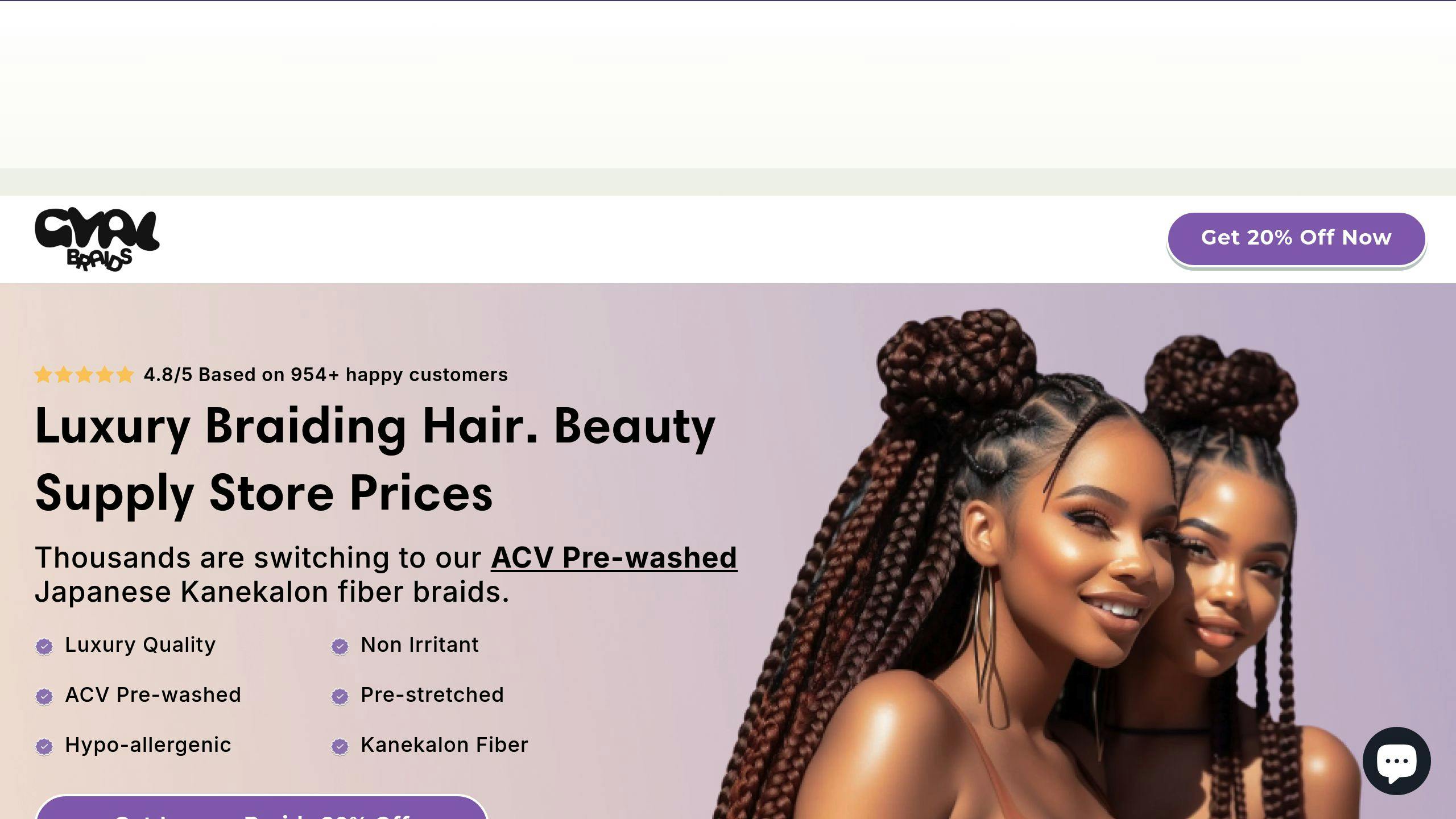Using synthetic braiding hair? A vinegar rinse can make all the difference by reducing scalp irritation, softening the hair, and removing harsh chemical residues. Here’s what you need to know:
- Why it matters: Synthetic hair often has an alkaline coating that can cause itching and discomfort.
- How it works: A simple mix of vinegar and water neutralizes these residues, balancing the pH.
-
Steps:
- Mix 1 part apple cider vinegar with 3 parts warm water.
- Soak the hair for 20 minutes.
- Rinse with cool water and air dry.
Prefer convenience? Pre-washed options like Gyal Braids skip the prep and are ready to use, but they cost more.
Quick Tip: If you’re sensitive to synthetic hair, a vinegar rinse or pre-washed hair can save you from irritation and make the braiding process more comfortable.
Step-by-Step Guide: Preparing and Using a Vinegar Rinse
What You'll Need
Before starting, make sure you have the following items:
- Apple cider vinegar (ACV)
- Warm water
- Large plastic basin or container
- Clean towel for drying
- Measuring cup
How to Mix the Vinegar Solution
Combine 1 part apple cider vinegar with 3 parts warm water. For example, if you're preparing a rinse for a standard pack of braiding hair, you can mix 2 cups of apple cider vinegar with 6 cups of warm water. Want to add a pleasant scent? Include 2–3 drops of your favorite essential oil. Just make sure the water is warm - not hot - to avoid damaging the synthetic hair.
Soaking and Rinsing the Hair
- Unfold and separate the synthetic braiding hair.
- Fully submerge it in the vinegar solution, ensuring every strand is soaked.
- Let it sit for about 20 minutes.
- Rinse thoroughly with cool water until the vinegar smell is gone.
- Lay the hair out to air dry completely before using.
Once prepped, your braiding hair will feel smoother and cause less irritation during use.
Benefits of Using a Vinegar Rinse on Braiding Hair
Removing Harsh Chemicals
Synthetic braiding hair often has an alkaline coating that can cause irritation or discomfort when installed. A vinegar rinse helps strip away these coatings, making the hair safer to use while keeping the synthetic fibers intact [1]. This simple cleaning step ensures your braiding hair is free from potentially harmful residues before use.
Reducing Scalp Irritation and Allergies
A key advantage of a vinegar rinse is its ability to minimize scalp issues. Many people experience itching, redness, or even allergic reactions when using untreated synthetic hair. Treating the hair with vinegar can help reduce or even eliminate these problems.
Chia from Just Peachy Co. shared that using a vinegar rinse has greatly reduced irritation for her and others [2].
Making Hair Easier to Work With
Using a vinegar rinse can also improve the feel and appearance of synthetic hair. It softens the fibers, reduces artificial shine, and makes the hair easier to manage. While this process takes some effort [2], many users find the added comfort and improved look of the hair worth the time.
For those who want to skip the preparation, pre-washed synthetic hair is an option that provides convenience without the need for additional steps.
sbb-itb-2cead6a
How to Clean Synthetic Hair Before Braiding with ACV Rinse
Considering Pre-Washed Alternatives
If you’re looking for a hassle-free option that skips the vinegar rinse, pre-washed synthetic braiding hair could be just what you need. This ready-to-use solution has become a favorite among both professional stylists and at-home users.
Why Choose Pre-Washed Hair?
Pre-washed braiding hair is treated beforehand to remove any lingering chemicals, saving you time and effort. Plus, it ensures consistent quality across all bundles, avoiding the unpredictability of DIY rinses. Some standout perks include:
- Ready-to-use right out of the pack
- Thoroughly cleaned to minimize irritation
- Consistent results every time
- Pre-stretched for quicker and easier installation
Gyal Braids: A Convenient Choice

One popular option is Gyal Braids, which offers pre-washed, hypoallergenic, and pre-stretched Kanekalon braiding hair. Their products are designed to be scalp-friendly and easy to work with. Key features include:
- Non-irritating for sensitive scalps
- Anti-bacterial treatment
- No chemical odors
- Eight bundles per pack
At $39.99 per pack, pre-washed options like Gyal Braids are pricier than untreated synthetic hair. However, many users find the convenience and peace of mind worth the extra cost. If you'd rather stick with a budget-friendly approach, the vinegar rinse method is still an effective way to prepare synthetic hair.
Conclusion
Summing Up the Vinegar Rinse Method
Using a vinegar rinse with a 1:3-4 vinegar-to-water ratio is an affordable and straightforward way to prepare synthetic braiding hair. This method can help minimize scalp irritation and make the braiding process more comfortable. Now, let’s see how it stacks up against pre-washed hair options.
Deciding What Works Best for You
Both the vinegar rinse and pre-washed hair have their own perks, depending on your needs and preferences. If you experience scalp irritation after getting your hair braided, applying a diluted apple cider vinegar (ACV) solution (1:3 ratio) directly to the scalp can help ease discomfort [1][3].
Pre-washed options, like Gyal Braids, provide a hassle-free alternative but come with a higher price tag.
When deciding between the two, think about these factors:
- How much time and money you’re willing to spend
- Whether your scalp reacts to synthetic hair
- The level of convenience you’re looking for
- Your past experiences with braiding hair
Whichever method you go with, both can help make the braiding process more comfortable while keeping your scalp and natural hair in good shape.

